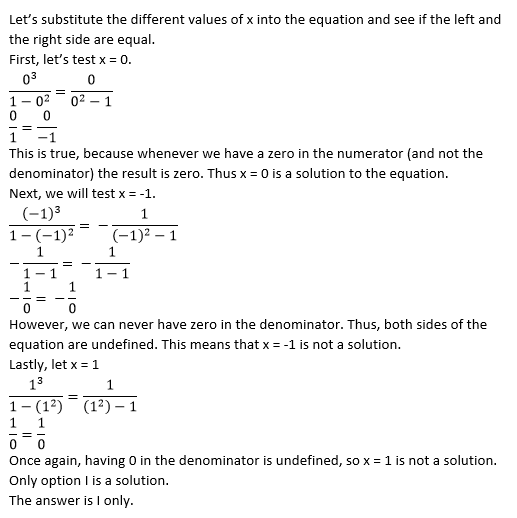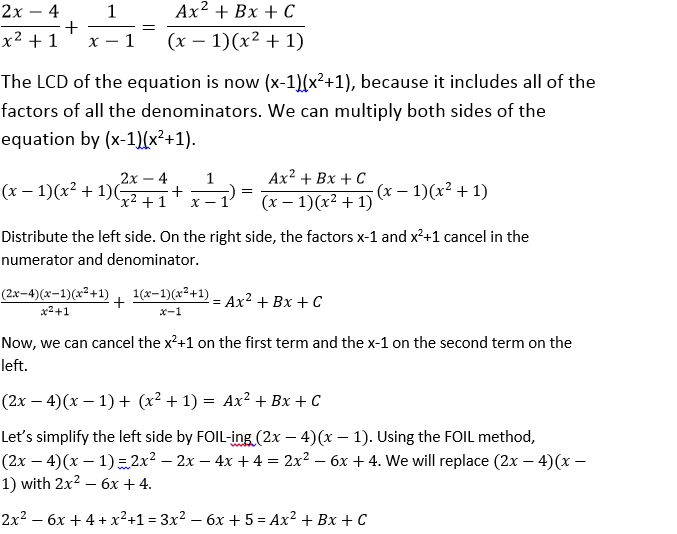Linear / Rational / Variable Equations - SAT Math
Card 0 of 20
Find the solution to the following equation if x = 3:
y = (4x2 - 2)/(9 - x2)
Find the solution to the following equation if x = 3:
y = (4x2 - 2)/(9 - x2)
Substituting 3 in for x, you will get 0 in the denominator of the fraction. It is not possible to have 0 be the denominator for a fraction so there is no possible solution to this equation.
Substituting 3 in for x, you will get 0 in the denominator of the fraction. It is not possible to have 0 be the denominator for a fraction so there is no possible solution to this equation.
Compare your answer with the correct one above

I. x = 0
II. x = –1
III. x = 1
I. x = 0
II. x = –1
III. x = 1
Compare your answer with the correct one above
Compare your answer with the correct one above
A fraction is considered undefined when the denominator equals 0. Set the denominator equal to zero and solve for the variable.


A fraction is considered undefined when the denominator equals 0. Set the denominator equal to zero and solve for the variable.
Compare your answer with the correct one above
Solve:

Solve:
First, distribute, making sure to watch for negatives.


Combine like terms.

Subtract 7x from both sides.

Add 18 on both sides and be careful adding integers.

First, distribute, making sure to watch for negatives.
Combine like terms.
Subtract 7x from both sides.
Add 18 on both sides and be careful adding integers.
Compare your answer with the correct one above
Solve:

Solve:
First, distribute the  to the terms inside the parentheses.
to the terms inside the parentheses.


Add 6x to both sides.

This is false for any value of  . Thus, there is no solution.
. Thus, there is no solution.
First, distribute the 
Add 6x to both sides.
This is false for any value of 
Compare your answer with the correct one above
Solve  .
.
Solve 
By definition, the absolute value of an expression can never be less than 0. Therefore, there are no solutions to the above expression.
By definition, the absolute value of an expression can never be less than 0. Therefore, there are no solutions to the above expression.
Compare your answer with the correct one above
, 
In the above graphic, approximately determine the x values where the graph is neither increasing or decreasing.
, 
In the above graphic, approximately determine the x values where the graph is neither increasing or decreasing.
We need to find where the graph's slope is approximately zero. There is a straight line between the x values of  , and
, and  . The other x values have a slope. So our final answer is
. The other x values have a slope. So our final answer is  .
.
We need to find where the graph's slope is approximately zero. There is a straight line between the x values of 


Compare your answer with the correct one above
Compare your answer with the correct one above
In the equation below,  ,
,  , and
, and  are non-zero numbers. What is the value of
are non-zero numbers. What is the value of  in terms of
in terms of  and
and  ?
?

In the equation below, 





Compare your answer with the correct one above
Compare your answer with the correct one above
Solve for x:

Solve for x:
The first step is to cancel out the denominator by multiplying both sides by 7:


Subtract 3 from both sides to get  by itself:
by itself:


The first step is to cancel out the denominator by multiplying both sides by 7:
Subtract 3 from both sides to get 
Compare your answer with the correct one above
Solve for  and
and  using elimination:
using elimination:


Solve for 

When using elimination, you need two factors to cancel out when the two equations are added together. We can get the  in the first equation to cancel out with the
in the first equation to cancel out with the  in the second equation by multiplying everything in the second equation by
in the second equation by multiplying everything in the second equation by  :
:


Now our two equations look like this:


The  can cancel with the
can cancel with the  , giving us:
, giving us:


These equations, when summed, give us:


Once we know the value for  , we can just plug it into one of our original equations to solve for the value of
, we can just plug it into one of our original equations to solve for the value of  :
:





When using elimination, you need two factors to cancel out when the two equations are added together. We can get the 


Now our two equations look like this:
The 

These equations, when summed, give us:
Once we know the value for 

Compare your answer with the correct one above
Give the solution set of the rational equation 
Give the solution set of the rational equation
Multiply both sides of the equation by the denominator  :
:


Rewrite both expression using the binomial square pattern:


This can be rewritten as a linear equation by subtracting  from both sides:
from both sides:


Solve as a linear equation:




Multiply both sides of the equation by the denominator 
Rewrite both expression using the binomial square pattern:
This can be rewritten as a linear equation by subtracting 
Solve as a linear equation:
Compare your answer with the correct one above
Solve:

Solve:

Multiply by  on each side
on each side

Subtract  on each side
on each side

Multiply by  on each side
on each side

Multiply by 
Subtract 
Multiply by 
Compare your answer with the correct one above
A store sells potatoes for $0.24 and tomatoes for $0.76. Fred bought 12 individual vegetables. If he paid $6.52 total, how many potatoes did Fred buy?
A store sells potatoes for $0.24 and tomatoes for $0.76. Fred bought 12 individual vegetables. If he paid $6.52 total, how many potatoes did Fred buy?
Set up an equation to represent the total cost in cents: 24P + 76T = 652. In order to reduce the number of variables from 2 to 1, let the # tomatoes = 12 – # of potatoes. This makes the equation 24P + 76(12 – P) = 652.
Solving for P will give the answer.
Set up an equation to represent the total cost in cents: 24P + 76T = 652. In order to reduce the number of variables from 2 to 1, let the # tomatoes = 12 – # of potatoes. This makes the equation 24P + 76(12 – P) = 652.
Solving for P will give the answer.
Compare your answer with the correct one above
Kim is twice as old as Claire. Nick is 3 years older than Claire. Kim is 6 years older than Emily. Their ages combined equal 81. How old is Nick?
Kim is twice as old as Claire. Nick is 3 years older than Claire. Kim is 6 years older than Emily. Their ages combined equal 81. How old is Nick?
The goal in this problem is to have only one variable. Variable “x” can designate Claire’s age.
Then Nick is x + 3, Kim is 2x, and Emily is 2x – 6; therefore x + x + 3 + 2x + 2x – 6 = 81
Solving for x gives Claire’s age, which can be used to find Nick’s age.
The goal in this problem is to have only one variable. Variable “x” can designate Claire’s age.
Then Nick is x + 3, Kim is 2x, and Emily is 2x – 6; therefore x + x + 3 + 2x + 2x – 6 = 81
Solving for x gives Claire’s age, which can be used to find Nick’s age.
Compare your answer with the correct one above
If 6h – 2g = 4g + 3h
In terms of g, h = ?
If 6h – 2g = 4g + 3h
In terms of g, h = ?
If we solve the equation for b, we add 2g to, and subtract 3h from, both sides, leaving 3h = 6g. Solving for h we find that h = 2g.
If we solve the equation for b, we add 2g to, and subtract 3h from, both sides, leaving 3h = 6g. Solving for h we find that h = 2g.
Compare your answer with the correct one above
If 2x + y = 9 and y – z = 4 then 2x + z = ?
If 2x + y = 9 and y – z = 4 then 2x + z = ?
If we solve the first equation for 2x we find that 2x = 9 – y. If we solve the second equation for z we find z = –4 + y. Adding these two manipulated equations together we see (2x) + (y) = (9 – y)+(–4 + y).
The y’s cancel leaving us with an answer of 5.
If we solve the first equation for 2x we find that 2x = 9 – y. If we solve the second equation for z we find z = –4 + y. Adding these two manipulated equations together we see (2x) + (y) = (9 – y)+(–4 + y).
The y’s cancel leaving us with an answer of 5.
Compare your answer with the correct one above
11/(x – 7) + 4/(7 – x) = ?
11/(x – 7) + 4/(7 – x) = ?
We must find a common denominator and here they changed the first fraction by removing a negative from the numerator and denominator, leaving –11/(7 – x). We add the numerators and keep the same denominator to find the answer.
We must find a common denominator and here they changed the first fraction by removing a negative from the numerator and denominator, leaving –11/(7 – x). We add the numerators and keep the same denominator to find the answer.
Compare your answer with the correct one above













